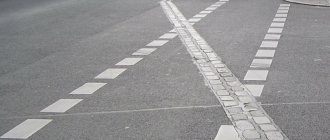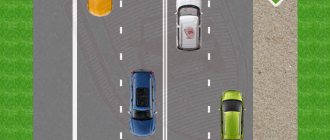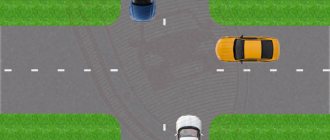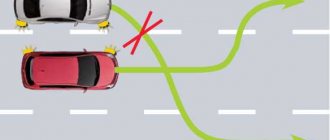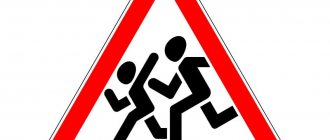The Supreme Court clarified who drivers should not yield to when leaving the yard
Some situations occurring on the road are often very difficult to understand even for experienced traffic police officers. But in practice, there are cases when you begin to doubt the professional suitability of some representatives of the law and order. A striking example of a very strange decision regarding one road accident is the Supreme Court ruling dated December 14, 2021, number 44-AD18-21.
When leaving the yard, keep your eyes open!
In the city of Perm last winter, a seemingly ordinary traffic accident occurred. Two cars collided. One of them was leaving the courtyard area, the other was driving along the main road:
“In violation of paragraph 8.3 of the Traffic Rules,” the materials of the administrative case say, “when leaving the adjacent territory, she did not give way to a Volkswagen Passat vehicle.”
As you can see, everything is very prosaic and standard. Any driver, even someone who has recently received a driver’s license, can easily say who is to blame for this accident; it is enough to be guided by one point of the traffic rules:
"8.3. When entering the road from the adjacent territory, the driver must give way to vehicles and pedestrians moving along it, and when leaving the road - to pedestrians and cyclists whose movement path he crosses.”
In other words, we give way to everyone, not just vehicles.
However, in our case, which was included in the practice of the Supreme Court, there was one significant nuance: the Volkswagen Passat was moving on a one-way road in the opposite direction .
These circumstances served as the basis for attracting... N.V. to administrative liability provided for in Part 3 of Article 12.14 of the Code of the Russian Federation on Administrative Offences.
And who is now to blame for this situation? To solve this problem, you need to introduce additional input. The street to which the exit from the yard was made was one-way. At the exit from the houses there was a sign 2.4 “Give way” and a sign notifying that the street on which the maneuver was being made was one-way.
The driver, or rather the driver, looked in the direction of the movement of vehicles and missed all the obstacles, and began to move. She could not imagine that an intruder would fly out at her from the other side.
See also: Yield to the obstacle on the right: the rule does not always work
Logic dictates that the one who was driving in the oncoming lane was to blame for the incident (the traffic police officers handed him a report on violation of the Traffic Rules under Part 3 of Article 12.16 of the Code of Administrative Offences), but a report was also issued against the woman under Part 3 of Article 12.14 of the Code of Administrative Offenses ( Failure to comply with the requirements to give way) and a fine of 500 rubles was issued.
That is, according to traffic police officers, the driver really should have foreseen such a situation and given way if necessary. Is this position correct?
According to the judge of the Sverdlovsk District Court of Perm, then the judge of the Perm Regional Court and the deputy chairman of the Perm Regional Court, the State Traffic Inspectorate employees did everything right and the woman violated the traffic rules. However, the administrative violation case reached the Supreme Court, which ruled otherwise.
LIABILITY FOR VIOLATION OF THESE RULES.
6.1. The owner of a motor vehicle, who through his own fault has damaged the fencing devices/its elements, may be limited in the right to store his motor vehicle in the local area until compensation for the damage caused by it.
6.2. In cases of violation of these Rules, the following sanctions may be applied to violators: 6.2.1. warning (for a primary and one-time violation); 6.2.2. persons who participated in financing the installation and operation of barriers can be transferred from the methods of opening barriers using a phone call, smartphone application and license plate recognition system to the method of opening using a PIN code for a period of 2 (two) weeks. The violator must be notified of the application of the above sanction to him no later than 24 hours before its implementation; 6.2.3. persons who did not participate in financing the installation and operation of barriers can be transferred from the method of opening barriers using a PIN code to the method of opening using applications to the responsible person for a period of 2 (two) weeks. Also, such violators retain the right to pay for access using a phone call, smartphone application, number plate recognition system and freely use the local area.
Supreme Court decision
«Establishing guilt involves proving a person’s guilt in committing an unlawful action (inaction), that is, the objective side of the act.
According to clause 8.3 of the Traffic Rules, the violation of which was charged to N.V. Borisova, when entering the road from the adjacent territory, the driver must give way to vehicles and pedestrians moving along it, and when leaving the road - to pedestrians and cyclists whose movement path he crosses.
See also: Can drivers be fined for the same traffic violation several times a day?
By virtue of paragraph 1.2 of the Traffic Rules, the requirement to give way (not create interference) means that a road user should not start, resume or continue moving, or carry out any maneuver if this may force other road users who have an advantage over him , change direction or speed.
Advantage (priority) is the right to priority movement in the intended direction in relation to other road users (Road Rules) ,” the resolution says.
Did the driver of the car, violating the Traffic Rules (proven by the protocol and diagram of the accident) and moving in the opposite direction on a one-way road, have an advantage over anyone? No! This means that other drivers had no obligation to give way to him on the basis of traffic regulations. And therefore, both the traffic police resolution and the subsequent court decisions are subject to cancellation. The imposition of a fine is also unfounded.
PERSONS RESPONSIBLE FOR COLLECTION OF FUNDS AND OPERATION OF BARRIERS.
3.1. Persons responsible for collecting funds and operating barriers are authorized by the general meeting of owners of an apartment building.
3.2. The person authorized by the general meeting of owners and responsible for the operation of barriers performs the following functions: 3.2.1. conducts the selection of proposals and enters into contracts with specialized organization(s) for the purchase and installation of barriers and related equipment, contracts for maintenance and the provision of 24-hour dispatch service; 3.2.2. maintains a register of motor vehicles indicating the full name of the resident, apartment number, state license plate of the vehicle, contact telephone number, information on the amount and date of making a one-time contribution to finance the organization and equipment of fencing devices and/or information on periodic payments for maintenance of fencing devices and round-the-clock services dispatch service; 3.2.3. ensures the exclusion of entry/exit using a phone call and a smartphone application and being in the local area for vehicle owners who have not promptly paid a one-time fee to finance the organization and equipment of fencing devices and/or periodic payments for the maintenance of fencing devices and 24-hour dispatch service . For such residents, entry using a PIN code remains available; 3.2.4. accepts and executes one-time written requests for entry of vehicles from residents; 3.2.5. about exceeding the established parking limits (guests, delivery, etc.), entering the local area using PIN codes, as well as other violations, a person authorized by the general meeting of owners will receive an SMS or other notification. Based on recorded abuses and consultations with members of the Council of Management, makes a decision on the application of sanctions against the violator; 3.2.6. organizes and pays for repair work in case of breakdowns or damage to barriers; 3.2.7. switches the barriers to manual mode in case of emergency situations.
3.3. The person authorized by the general meeting of owners and responsible for collecting funds performs the following functions: 3.3.1. collects a one-time contribution from homeowners and other persons to finance the organization and equipping of fencing devices, the formation of a reserve fund, as well as the collection of an annual fee for dispatching and maintenance; 3.3.2. transfers the data to the person responsible for the operation of the barriers, indicating the full name of the resident, apartment number, state license plate of the vehicle, contact telephone number, information about the amount and date of making a one-time contribution to finance the organization and equipment of fencing devices and/or information about periodic payments for maintenance fencing devices and 24-hour dispatch service; 3.3.3. maintains financial records of residents' funds and provides quarterly reports on them; 3.3.4. carries out the preparation of financial documents for funds received from residents or other persons; 3.3.5. carries out storage of technical, legal and financial documentation related to the installation and operation of barriers.
3.4. The work of those responsible for collecting funds and operating barriers can be rewarded at the request of the owners.
3.5. The person responsible for the operation of barriers, in cases of temporary absence due to illness, vacation or other valid reasons, has the right to appoint, at his discretion, a person temporarily performing his duties from among the members of the Management Board. The person temporarily acting as responsible for the operation of barriers is given the following for the period of execution: 3.5.1. technical documentation on barriers; 3.5.2. access to the system, allowing you to make changes to the registry; 3.5.3. keys to barriers; 3.5.4. contacts in the service organization. When transferring the above, a transfer act is drawn up. When returned to the responsible person - a return certificate. The acting acting authority acts on the basis of a power of attorney issued by the person responsible for the operation of the barriers for the period of his absence.
3.6. The person responsible for collecting funds, in cases of temporary absence due to illness, vacation or other valid reasons, has the right to appoint, at his discretion, a person temporarily performing his duties from among the members of the Board of Directors. The person temporarily acting as the person responsible for collecting funds is given the following for the period of execution: 3.6.1. financial documentation for barriers; 3.6.2. funds in the amount necessary to ensure the operation of the barriers. When transferring the above, a transfer act is drawn up. When returned to the responsible person - a return certificate. The acting acting authority acts on the basis of a power of attorney issued by the person responsible for collecting funds for the period of his absence.
We draw a conclusion
Thus, for those drivers who did not violate the Traffic Rules at the time of the accident, this court decision can be extremely useful, because incidents often occur in the law enforcement area. Some people are “lucky” to run into an undeserved small fine, but for others, someone else’s impudence can cost them their rights or even their freedom.
Remember : a violator of traffic rules cannot take advantage of other road users. Proven by the Supreme Court more than once!
